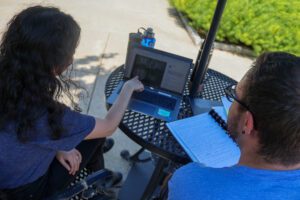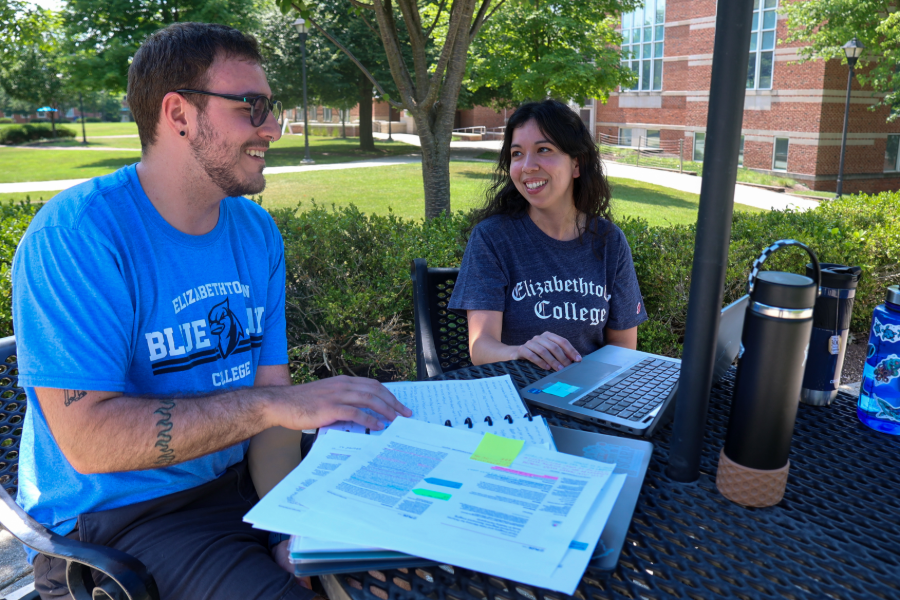Human memory has its flaws, which can often lead to people mistakenly remembering information that they were never exposed to. This phenomenon is known as false memory and is the focus of Elizabethtown College Neuroscience major Ryder Pavela’s research through the Summer Creative Arts and Research Program (SCARP).
Pavela, who aims to become an ophthalmologist (eye care specialist), is working alongside faculty mentor and Assistant Professor of Psychology, Jennifer Wittmeyer to analyze magnetic resonance imaging (MRI) data to determine what brain regions are making us encode false information.
Title of Research
Examination into the Relationships Between Visual Imagery, False Memory, and Gray Matter Structure
Student Researcher
Ryder Pavela ’25 (Neuroscience major)
Faculty Mentor
Jennifer Wittmeyer, Assistant Professor of Psychology
What are you researching?
Pavela: We are interested in uncovering neural mechanisms that underlie mistakes in memory formation, specifically the false memory phenomenon. We analyzed magnetic resonance imaging (MRI) data from participants, who were shown pictures and asked to recount what they saw in our study. To analyze the behavioral data, we used signal detection theory (SDT) as a way to quantify sensitivity (d’) to correct trials in the presence of noise. Decision criterion (C) influences the decision-making strategy used. It measures how conservative the participants were with their responses. We were interested in the relationship between cortical thickness, a measure of gray matter structure, in brain regions important for memory and visual imagery and performance on the false memory task.
Our findings suggest that cortical thickness in the middle and inferior occipital cortices positively correlated with sensitivity to correct trials or “hits.” Furthermore, we are interested in whether visual imagery moderated any brain structure-behavior relationships. We found that cortical thickness of the inferior parietal lobe was associated with a decision criterion score for all trials, including false alarms. This relationship was moderated by visual imagery scores, where people with high visual imagery were less conservative with their responses. These findings agree with functional MRI findings suggesting that the inferior parietal lobe may be important for false memory and the occipital lobe for correct memory formation.
Why did you choose this topic?
Pavela: I chose this topic because I am interested in understanding how brain structure affects behavior, as well as in visual processing pathways within the brain, which was a central concept of this research topic.
What is the most interesting aspect of this research?
Pavela: The most interesting part of this research has been identifying my research variables supported by current scientific literature, and trying to understand and interpret my results has been challenging but enjoyable as well.
What are you hoping to accomplish through this research project?
Pavela: I hope this research may support our understanding of behavioral outcomes stemming from structural differences within the brain. This research may provide evidence to support the roles of specific brain regions in the formation and recognition of information.
How has your faculty mentor helped you?
Pavela: It has been very helpful having Dr. Wittmeyer as my mentor. She has helped me understand how you can obtain structural data from a functional neuroimaging study for further research. Her feedback and support have been beneficial throughout this time.
Hear from the faculty mentor – Jennifer Wittmeyer
“SCARP is such a wonderful and enriching experience. As professors, we often don’t have as much time to work on research during the school year, so this gives us some dedicated time to work on something we’re passionate about. I think the most rewarding aspect of the program is knowing that my student is getting personalized feedback on a complicated topic and can delve into research at a higher caliber than they would have if they were taking many other classes at the same time.”

